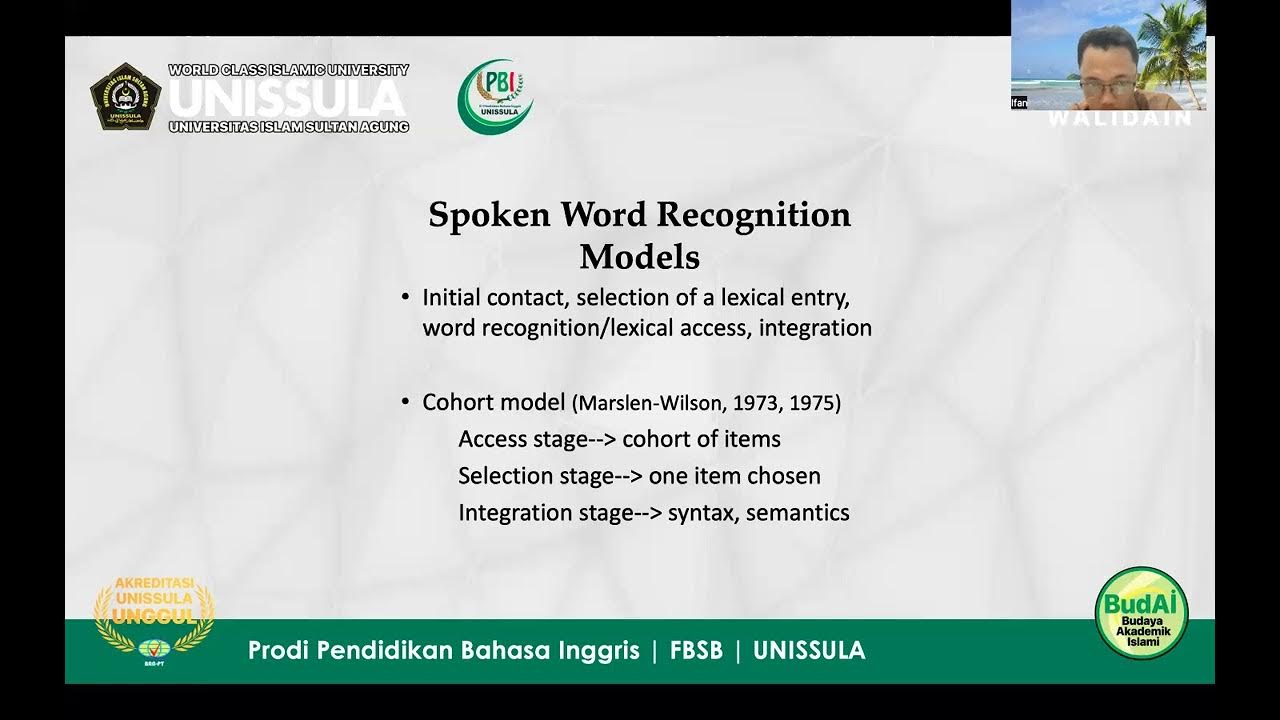PBIN4327 Psikolinguistik - Perkembangan Bahasa Anak
Summary
TLDRThis program provides an overview of language development in children acquiring their first language, focusing on key stages such as phonological, morphological, lexical, semantic, and pragmatic acquisition. It explains how children master sounds, words, and syntax in their language journey. The video explores various aspects of acquisition, from cooing at 6 weeks to acquiring basic vocabulary, verbs, and adjectives. It also delves into the development of meaning through semantics and the social use of language in pragmatics. The course highlights the gradual learning process that shapes children's communication skills, with examples to illustrate each stage.
Takeaways
- 😀 Language development in children involves the acquisition of phonological, morphological, syntactic, lexical, semantic, and pragmatic elements.
- 😀 At 6 weeks, children start producing sounds that resemble vowels and consonants, marking the early stages of phonological development.
- 😀 Children progress to the cooing stage between 8 to 20 weeks, and by 6 months, they begin mixing consonants and vowels (babbling).
- 😀 Phonological development continues, with children at 2 years beginning to pronounce words with a consonant at the end (though not always correctly).
- 😀 Morphological acquisition is more often seen in free morphemes (e.g., basic words) rather than bound morphemes, with nouns being acquired earlier than verbs.
- 😀 According to research, children acquire nouns first, followed by verbs, adjectives, and function words.
- 😀 Examples of morphological acquisition include children using words like 'milk,' 'cars,' 'eat,' 'buy,' and 'delicious.'
- 😀 Syntactic acquisition is marked by the development of phrases, clauses, and sentences, with children mastering simple word classes and gradually varying their functions.
- 😀 Lexical acquisition is influenced by the child's environment, with children learning words related to their immediate surroundings (e.g., children in rural areas learning farm-related vocabulary).
- 😀 Semantic acquisition involves attaching meaning to words based on sensory observations, with children mastering word meanings gradually, starting with familiar objects or concepts.
- 😀 Pragmatic acquisition focuses on communicative intentions, conversational skills, and the development of cohesive discourse, where children learn social language skills through interactions with adults.
Q & A
What is the primary focus of the psycholinguistics course discussed in the program?
-The course focuses on language development in children, specifically how they acquire their first language.
What are the key stages of phonological acquisition in children?
-Phonological acquisition progresses from producing vowel-like sounds at 6 weeks, to cooing at 8 to 20 weeks, to mixing consonants and vowels at 6 months, and eventually to the inability to pronounce consonant clusters at 3 years.
How does morphological acquisition occur in children?
-Children acquire both free and bound morphemes, with free morphemes (basic words) being more commonly acquired. The acquisition of nouns generally precedes that of verbs, adjectives, and function words.
What did Blom and Tardif state about the acquisition of verb and noun classes?
-Blom and Tardif stated that verbs are acquired earlier than other word classes and are used more frequently by children.
What is the order of acquisition of words in children's lexicon according to Darjojojo's research?
-According to Darjojojo's research, the acquisition of children's lexicon is dominated by nouns, followed by verbs, adjectives, and function words.
How do environmental factors influence lexical acquisition in children?
-Children acquire vocabulary based on their environment. For example, children in rural farming areas may acquire words like 'kul' (field) and 'sawah' (rice paddy) earlier than children in urban areas who might master words like 'crayon' and 'computer' later.
What is the role of semantics in children's language acquisition?
-Semantics in children's language acquisition involves learning the meanings of words based on sensory experiences and attaching fixed meanings to specific language sounds.
Can you provide an example of semantic acquisition in children?
-An example of semantic acquisition is when a toddler calls all four-legged animals 'da,' or when a child calls various fruits like apples and oranges 'apoi' due to their similar shapes and sizes.
What is pragmatic acquisition, and how does it develop in children?
-Pragmatic acquisition involves learning how to use language in context. It starts with communicative intentions, such as smiling or vocalizing, and develops into understanding conversational rules, politeness, and cohesive discourse through adult interactions.
What are the three key stages of pragmatic development in children?
-The three stages of pragmatic development are: 1) acquisition of communicative intention, 2) development of conversational skills, and 3) learning tools to form cohesive discourse with adult conversation partners.
Outlines

This section is available to paid users only. Please upgrade to access this part.
Upgrade NowMindmap

This section is available to paid users only. Please upgrade to access this part.
Upgrade NowKeywords

This section is available to paid users only. Please upgrade to access this part.
Upgrade NowHighlights

This section is available to paid users only. Please upgrade to access this part.
Upgrade NowTranscripts

This section is available to paid users only. Please upgrade to access this part.
Upgrade Now5.0 / 5 (0 votes)





